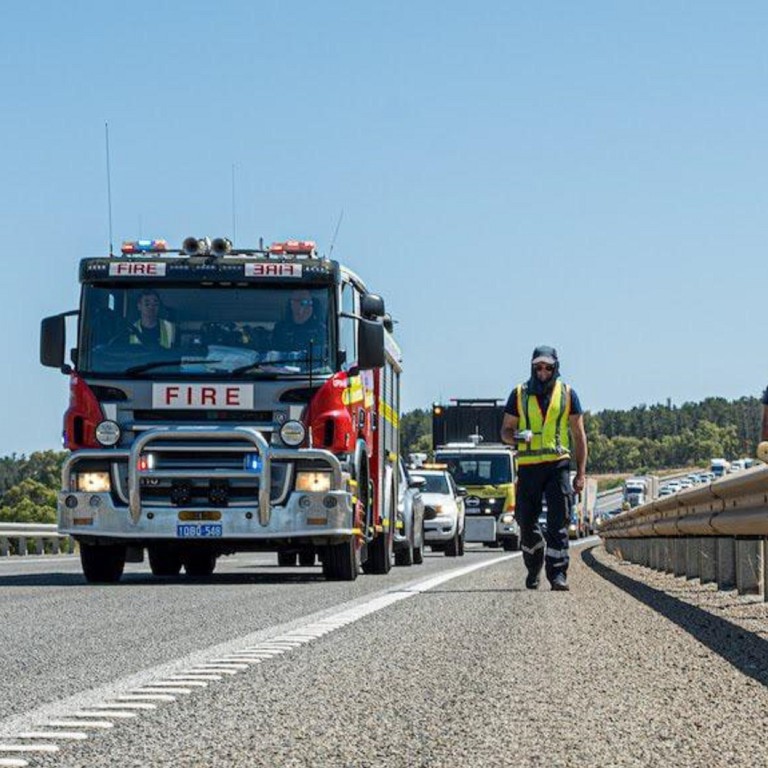
Emergency services scour Australian outback for dangerous lost radioactive capsule
- The small silver cylinder contains caesium 137 and emits the equivalent of 10 X-rays an hour. It can cause skin damage, burns and radiation sickness
- It’s believed to have fallen off the back of a truck en route to Perth. Authorities are attempting to locate the capsule using the gamma rays it emits
Emergency services said they were hampered by a lack of equipment and have called on the federal government and other states to provide assistance.
Western Australia’s Department of Fire and Emergency Services has deployed teams with handheld radiation detection devices and metal detectors along 36km (22 miles) of a busy freight route to look for the 8 millimetres by 6 millimetres (0.31 inches by 0.24 inches) unit.
It’s believed to have fallen off the back of a truck on a 1,400km (870-mile) journey from the Rio Tinto mine in Newman to the Perth suburb of Malaga.
“What we’re not doing is trying to find a tiny little device by eyesight,” said Superintendent Darryl Ray, adding they were concentrating on populated areas north of Perth and strategic sites along the Great Northern Highway.
“We’re using the radiation detectors to locate the gamma rays,” he said.
Authorities were also using the truck’s GPS data to determine the exact route the driver took and where it stopped after it left the mine on or about January 10.
There are concerns the solid capsule may have already become lodged in another vehicle’s tyre and potentially be hundreds of kilometres away from the search area.
Giant coal mine blocked on human rights grounds in Australia
It’s believed a screw became loose inside a large lead-lined gauge and the unit fell through a hole.
Rio Tinto said it contracted an expert radioactive materials handler to package the capsule and transport it “safely” to the depot and was not told it was missing until Wednesday.
Chief Health Officer Andrew Robertson defended the Western Australia government’s decision to wait two days to inform the public on Friday, saying the mine and depot had to be searched and excluded, and the route confirmed.
He said the capsule was packed in accordance with the radiation safety transport and regulations inside a box bolted onto a pallet.
Our concern is someone will pick it up, not knowing what it is, think this is something interesting [and] keep it
“We believe the vibration of the truck may have impacted the integrity of the gauge, that it fell apart and the source actually came out of it,” he said. “It is unusual for a gauge to come apart like this one has.”
An investigation will look at the handling of the gauge and capsule at the mine site, the transport route used and the procedures at the depot in Perth after it arrived on January 16.
Police have determined the incident to be an accident and no criminal charges are likely.
Authorities ruled out theft at the depot before the box was opened on Wednesday.
Why is Japan dumping radioactive water in the sea?
The small silver cylinder is a caesium 137 ceramic source commonly used in radiation gauges.
Robertson previously said the unit emits the equivalent of 10 X-rays in an hour and members of the public should stay at least 5 metres (16 feet) away. Contact could result in skin damage, burns and radiation sickness, including impacts to the immune and the gastrointestinal systems.
Long-term exposure could also cause cancer, however, experts say the capsule cannot be weaponised.
“Our concern is someone will pick it up, not knowing what it is, think this is something interesting [and] keep it,” Robertson said.
Rio Tinto Ltd’s iron ore division chief Simon Trott apologised on Monday for the incident.
“We are taking this incident very seriously. We recognise this is clearly very concerning and are sorry for the alarm it has caused in the Western Australian community,” Trott said in a statement.
“Rio Tinto engaged a third-party contractor, with appropriate expertise and certification, to safely package the device in preparation for transport off-site ahead of receipt at their facility in Perth,” he said, adding that Rio was also conducting its own investigation into how the loss occurred.
“We have completed radiological surveys of all areas on site where the device had been, and surveyed roads within the mine site as well as the access road leading away from the Gudai-Darri mine site,” Trott said.
Additional reporting by Reuters

